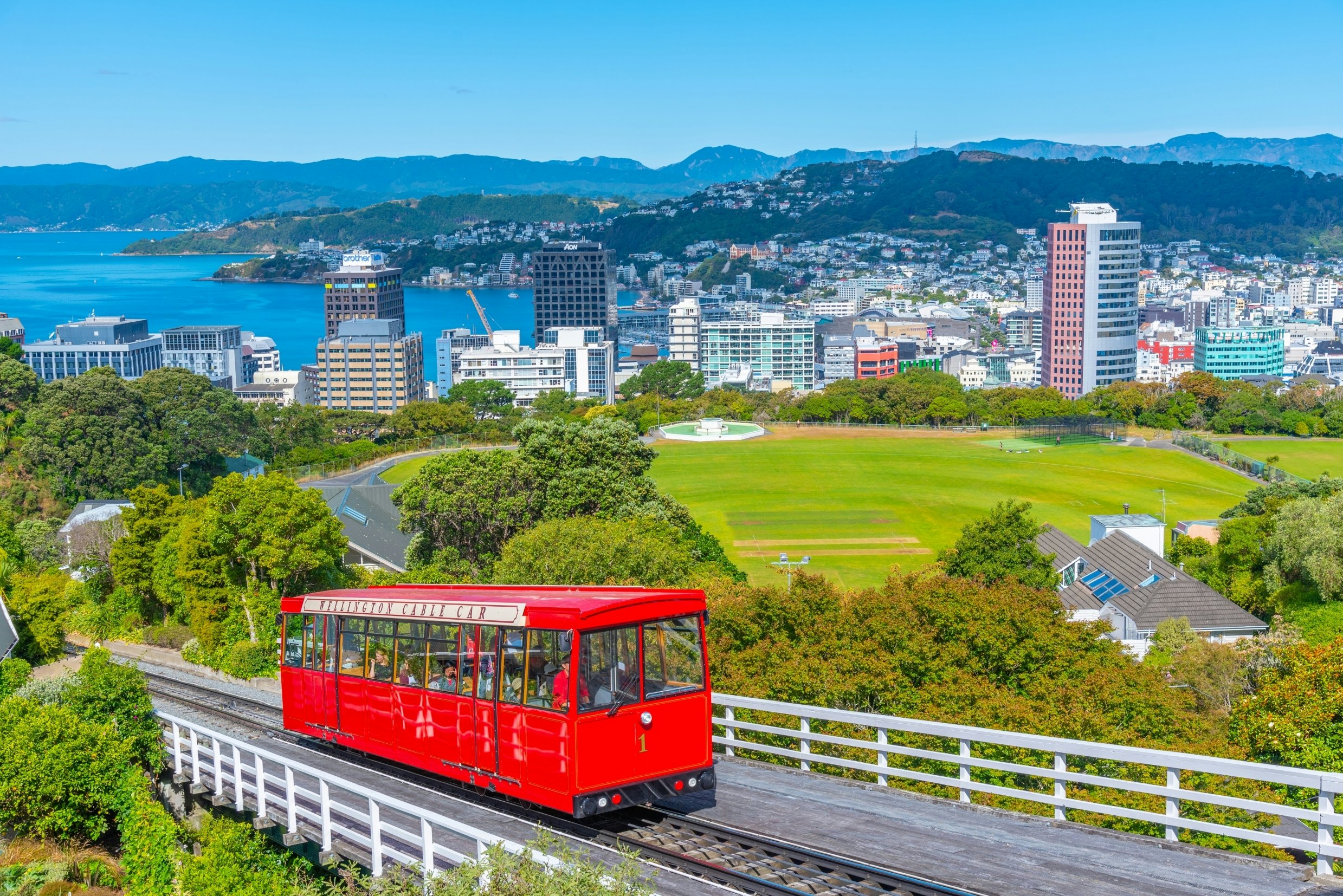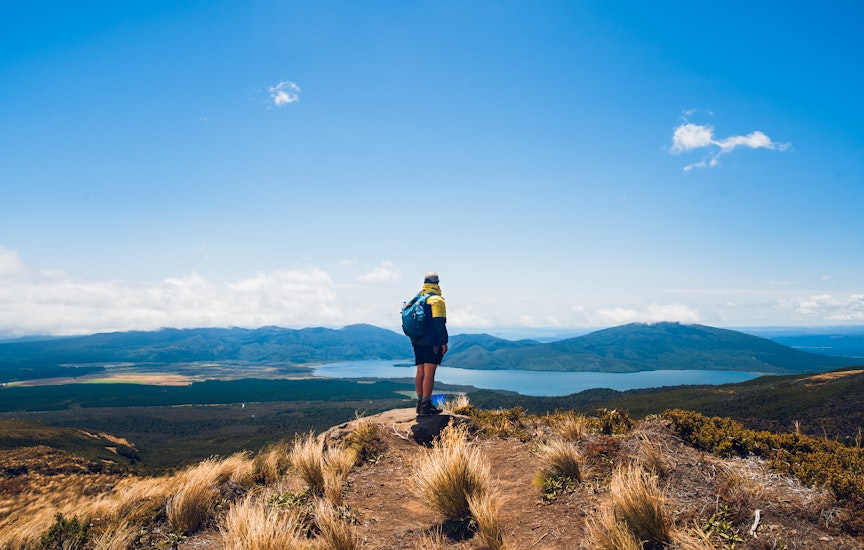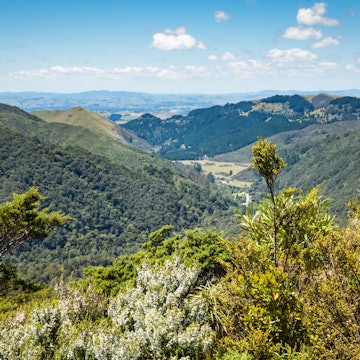

Views over Wellington, New Zealand. Jordan Tan/Shutterstock
Located on the southern tip of the North Island, Wellington (Whanganui-ā-Tara or Pōneke) is equal parts urban and outdoorsy, with towering civic buildings, characterful neighborhoods, and trendy bars and restaurants lining its accessible waterfront and beaches. New Zealand’s inclusive capital city is home to the country's largest LGBTQ+ community. It’s cycle-friendly too, as new bike lanes are added to what is already a compact and walkable city. Ready to explore? Plan your time, budget and activities with this guide.

When should I go to Wellington?
Spring (September to November) brings longer days and events like World of WearableArts (WOW) – Wellington’s annual wearable art competition – but it can also bring rain and fierce wind. New Zealand’s summer (December to February) is a great time to visit Wellington with its long warm days (averages of 21°C/70°F in February) and busy social calendar. Gardens Magic, a long-standing month-long music series, is held in the Wellington Botanic Gardens and there is international test cricket at the Basin Reserve. This is the perfect time to cruise along the waterfront on rental scooters and e-bikes. Inner harbor swimming and sunbathing at Oriental Bay is a fine-weather must-do for citysiders, as is trail running and mountain biking the vertical tracks of Mt Victoria.
Unlike other more touristed regions such as Queenstown or Piopiotahi/Milford Sound, Wellington doesn’t attract the same peak summer crowds, making it easier to find accommodations and grab a sunny seat at an outdoor cafe or rooftop bar. Year-round, though, it’s best to book ahead for dinner. Wellington’s restaurants are known for excellent, friendly service, but spaces – much like the city itself – tend toward the boutique and smaller scale, so fill up quickly, especially on weekends. In January, it pays to check restaurant opening hours. It’s not uncommon for some of the city’s popular spots to close for a week or two as the city empties out and locals travel away for summer vacation.
While I love fall’s milder, settled weather, winter is my favorite time in Wellington. It’s cold, but the season’s starry skies make up for it, especially during Matariki, a national vacation when people gather at organized events to look skyward and celebrate the Māori New Year. Rugby fever inevitably takes hold when the All Blacks, New Zealand’s national team, take on rivals at the Cake Tin (Wellington’s main sports stadium) every season. August’s big event is Wellington on a Plate (WOAP), a not-to-be-missed, boundary-pushing food festival, which is bookended by Beervana, a popular annual craft beer event.

How much time should I spend in Wellington?
Wellington can be explored in a weekend. But to go beyond the city center to neighborhoods and the wider region, you’ll need to give yourself longer. Here are two itineraries to help you plan your time.
A weekend exploring the city on foot and touring Wētā Workshop
On foot, head to the Museum of New Zealand Te Papa Tongarewa. Try Te Papa’s 1-hour introductory tour to familiarize yourself with the main exhibitions and the museum’s history, then allow 2 to 3 hours to explore for yourself. Grab lunch at Karaka Café, specialists in Pacific kai (food), and sign up for a guided walking or waka (Māori canoe) tour at Te Wharewaka o Pōneke (a Māori-owned operator located on the same site). Eat dinner in town – I love award-winning Chaat Street’s crispy fish fillets coated in spiced chickpeas. End the night at the Little Beer Quarter, a tucked-away craft beer bar.
Spend your second day in the suburb of Miramar exploring Wētā Workshop, a film production house famous for The Lord of the Rings and Avatar special effects and props. Choose from the various tours and workshops on offer, such as the 90-minute workshop tour, introductory costume-making, or special effects and sculpture workshops, before refueling at The Larder, a popular nearby eatery.

A multiday self-drive adventure on the Kāpiti Coast
Hire a rental car and take the Kāpiti Expressway to Paraparaumu, where you’ll find the HQ of Kāpiti Island Nature Tours. From there (or online beforehand), book an overnight tour of Kāpiti Island for guided hikes, wildlife spotting and to meet a local family with iwi (Māori tribal) ties to the island. Returning to the mainland, make your way to Paekākāriki to start the 10km Paekākāriki Escarpment Track. Expect steep terrain, but truly stunning coastal views. Rest up at the well-priced Paekākāriki Holiday Park or splash out on a night or two in the Escarpment Domes, off-grid glamping domes in Pukerua Bay. Spend the next day strolling the beach and relaxing. Head back to Wellington via Porirua’s Pātaka Art + Museum. It’s a great destination for lunch, gift shopping and insight into the region’s vibrant multicultural heritage.
Is it easy to get in and around Wellington?
Wellington’s center is compact and designed for easy walking. Bus routes and cycleways extend from the city center to the suburbs. To go beyond the city center, rent a car from Wellington airport. App-operated car-share services Mevo and Cityhop cars can be rented at day or overnight rates using international licenses. Trains travel to the Kāpiti Coast and Masterton in the Wairarapa region.

Top things to do in Wellington
Explore the city’s art and culture
From the city center, it’s easy to explore Wellington’s many museums and galleries. Don't miss the Museum of New Zealand Te Papa Tongarewa on the waterfront and its Gallipoli: The Scale of Our War exhibition created by New Zealand film director Sir Peter Jackson. Nearby is the fascinating maritime history museum, portrait gallery and civic square, which is home to the capital’s City Gallery due to reopen in mid-2026. Opposite parliament is the National Library, where New Zealand’s founding document, Te Tiriti o Waitangi (Treaty of Waitangi), can be viewed.
Tour the government precinct
Explore New Zealand Parliament and go inside “the Beehive” (the government’s executive wing). Free daily walking tours run on-site. Across the road are the Old Government Buildings, a grand heritage structure built in the 1870s, open for guided and self-guided tours.
Look for New Zealand's most famous resident at Zealandia
It’s hard to beat a night tour of Zealandia Te Māra a Tāne, Wellington’s urban wildlife sanctuary, for the delight of glowworms and, if you’re lucky, seeing little spotted kiwi (pukupuku) – a threatened species of New Zealand’s national bird. A free e-shuttle runs from pickup points in the city and back throughout the day.
Wine, dine and shop your way around the city
Wellington offers some of New Zealand's best restaurants and shopping, with stores carrying wares and clothing from the trendiest made-in-NZ brands. Browse the vintage stores of Cuba Mall, or for something higher end, try Zambesi on Customhouse Quay, Workshop in the Old Bank Arcade and Gregory on Victoria St. For dining, head for one of the city's top restaurants – Logan Brown, Capitol, Rita and Charley Noble are all great choices – or enjoy sipping regional wines at specialty bars like Puffin on Ghuznee St or Noble Rot Wine Bar on Swan Lane.
My favorite thing to do in Wellington
Exploring the city on foot is one of my favorite things to do in Wellington. Hiking to the Mt Victoria Lookout from my Te Aro apartment takes me less than an hour (return) on dirt trails, through a pine forest and up to a peak with views over the city and harbor. Walking independently is fun: you can take things at your own pace and go where the mood (or the weather) takes you. But I also love a free guided city walking tour. I’ve done The Fabulous Carmen Rupe Tour, run by Walk Tours NZ, which tells the story of New Zealand’s first celebrity drag queen. Insightful too are the daily walking tours of New Zealand Parliament buildings. Te Ara Tapuwae o te Whare Pāremata (The Trodden Pathway of Parliament) is the free Māori history tour, which you can book online.

How much money do I need for Wellington?
Like the rest of New Zealand, Wellington isn't an inexpensive destination. Dynamic pricing combined with Wellington's status as a cultural, business and government hub means that accommodations, in particular, can eat into your budget. (If you've got a rental car, plan to spend a extra NZ$50 for overnight parking alone if you're staying in or near the city center.) However, it's possible to stretch your budget further by choosing to stay in a hostel and taking advantage of the city's free attractions, with wandering the waterfront or visiting the Wellington Botanic Garden both being divine ways to spend the day.
Day pass (bus/rail) for one adult: NZ$14
Public ferry for one adult: NZ$16
E-bike hire for one adult: NZ$70
Espresso coffee: NZ$5.50
Entry for one adult to Museum of New Zealand Te Papa Tongarewa: NZ$35
Guided walking tours of New Zealand Parliament: Free
Hostel bed in shared dorm: NZ$50
Mid-range hotel accommodation: NZ$300
Beer/pint at the bar: NZ$11
Wine by the glass: NZ$12
Cocktail: NZ$14
Simple dinner for one adult: NZ$55
Fancy dinner: NZ$110
What do I pack for a visit to Wellington?
The world’s southernmost capital city is in the wind zone known as the Roaring Forties, ranking it among the world’s windiest cities (alongside Cape Town in South Africa and Iceland’s Reykjavík). The trick is to dress in layers so you can add or subtract them depending on the actual weather you’re experiencing. Rest assured: the city enjoys plenty of calm blue-sky days too. But do pack something windproof, choose your hat with a stiff breeze in mind and leave the umbrella at home.















